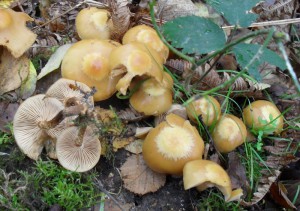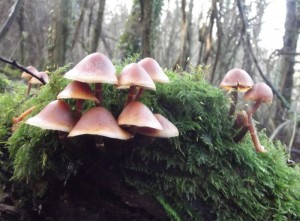24/03/2013
There are quite a few poisonous/edible lookalike pairs of species of fungi.
The most famous of these pairs is probably the death cap (Amanita phalloides) and the horse mushrooom (Agaricus arvensis), but there really isn’t any excuse for getting these two confused. Yes, they look rather similar, and they can grow in similar places, but a death cap emerges from a sac (a “volva”) and a horse mushroom does not. In other words, provided you do a bit of basic research, and keep your eye on the ball when it matters, then there is no reason to worry too much about getting them mixed up.
It is considerably easier to confuse fool’s funnel (Clitocybe rivulosa) with the miller (Clitopilus prunulus), and although the C. rivulosa is less dangerous than a death cap, it is still dangerous enough to regard the very-tasty miller as a species which should be left alone until you have got a good idea what you are doing. You certainly shouldn’t go near it until you’re absolutely certain you know how to identify the poisonous Clitocybes. But again…there’s no reason to regard the miller as too dangerous to eat.
The same cannot be said of sheathed woodtuft (Kuehneromyces mutabilis).
This species, I have recently discovered, is very tasty indeed. I now regard it amongst the very best of the edible wild fungi – one of the few that are worthy of being included in a recipe specifically as the main source of flavouring for the dish. It is also common – not very common, but common enough that I expect to find it every year, and with the added advantage of regularly appearing outside of the main mushroom season, as well as fruiting in abundance more often than not.
So what’s the problem? The problem is that this one has a lookalike that is not only deadly (containing the same toxins as the deadly amanitas), but which is extremely difficult to reliably distinguish from sheathed woodtuft. It goes by the name of “funeral bell” (Galerina marginata) and it is a species for which I had been searching, without success, for over a decade. Maybe I was missing it, or perhaps I was mis-identifying it as a Psathyrella, or a member of some other group that is of little interest to foragers. I suspect, though, that I just wasn’t lucky (or maybe unlucky) enough to find it.
I have always had a rule, you see, about edible/poisonous pairs of fungi: I don’t eat the edible one until I’ve found and identified the poisonous lookalike. Last autumn (2012) I broke this rule. I ran out of patience, having come across what I was convinced was sheathed woodtuft for the umpteenth time, and knowing they were supposed to be good eaters. So I decided to employ a new tactic, specially for this case. First I nibbled just a quarter of a cap (they are small). Just enough to get a taste, and to see if there would be an adverse reaction. Having survived this first taste (and discovering it was indeed very tasty), I ate one whole cap the next day. Again I waited, and again there was no adverse reaction. The following day, with the mushrooms still sitting in my fridge, I ate three of them. Again I waited, and again I woke up the next day having sufffered no ill-effects. By now I was confident of my identification and I finished off the rest of them, and they did not disappoint.
Then, on December 17th, while out on a walk across the South Downs organised by a friend of mine (not specifically a foraging walk, and not a route I had chosen) I was surprised and delighted to find, and identify in the field, the poisonous lookalike. My walking companions couldn’t quite understand why I was so excited about finding a mushroom that could not be eaten, but for me it was like any sort of collector who has come across something very special they have been seeking for many years. There it was, innocently sprouting from a log in a small, unmanaged tract of ancient woodland, nestled in the hills between Brighton and Lewes. I’d completed the pair, and I now feel considerably more confident for the future.
I still know nobody else who has eaten sheathed woodtuft. I have not given it to anyone else to eat (customers or friends), and I know of nobody in the foraging or mycological communities who’ve been brave (or silly) enough to take what looks like a pointless risk with their lives.
So why are they so hard to tell apart? They look very similar, and they grow in similar habitats (although sheathed woodtuft prefers deciduous stumps and funeral bell prefers conifers). They have a similar growth habit (at least sometimes they do, and that is enough.) Sheathed woodtuft tends to occur in greater numbers, and in much denser tufts, whereas funeral bell troops (it is distributed more sparsely over the log/stump.) The stems are also slightly different (funeral bell has a silky stem, sheated woodtuft is more “hairy”) – at least usually they are. And they also dry out differently after being made wet (sheathed woodtuft dries from the middle outwards, funeral bell dries from the edge inwards). The problem is that none of these distinguishing features is completely reliable, and when you’ve only ever seen the deadly lookalike once (or no times at all) then it is almost impossible to be 100% confident of your identification. Plus there’s always the nightmare possibility of both species sharing a stump.
So I’m afraid I still can’t recommend anybody go out foraging for sheathed woodtuft, and for now I still regard it as too dangerous for me to send customers home with, or give to my friends and family to eat. It is one thing taking a possible risk with my own life, but quite another to take risks with the lives of others.
Perhaps I’ll feel differently next time I come across what I now consider to be a delicacy. More likely, at least until I’ve eaten them a few times, or come across funeral bell a few more times, I shall just use the danger-factor as an excuse to scoff the lot myself!



Sheathed woodtufts are a commonly foraged mushroom in Russia. They’re called opyata (опята), their name deriving from the word for a stump. You might want to look into Russian sources for more information on collecting and identifying them.
Thanks for the information.
Opyata (опята) are actually honey mushroom (armillaria melea), which are much easier to distinguish.
Hi Alex
I am not sure I understand your comment. This article isn’t about honey fungus.
Geoff
I think Alex was saying that the translation in the comment above (опята) is not correct, as it means honey fungus rather than sheathed Woodtuft (so any research would be futile). Unfortunately I don’t understand Russian so can’t confirm!
Aldi sells a frozen spaetzel dish with sheathed wood tufts. That’s why I googled it and found your page. Absolutely delicious but jsn’t that odd? Says sheathed woodtuft right on front of the box
I will look out for it!
Same reason brought me here!
Day before yesterday I FINALLY found Kuehneromyces mutabilis that looked exactly like in the literature & am now about to prepare & eat them. I live in France & I’ve never read that it’s a summer mushroom, but now I know. And it’s because the season is exceptionally wet that the fungi look like in the pictures. Several years ago, my mycological society gave me a small group of Galerina marginata, which I have conserved in vinegar. Color’s all off now, but the shape is clear to see. I’ll let you know if I drop dead!
Enjoy!
Foraged this mushroom for the first time in yesterday in Finland, I consumed one cap and was amazed by the beautiful flavour. From what I know they are foraged quite often in Finland.
Hi Geoff, I just read your article on the “sheathed woodtuft” and found it a really good read. A friend asked me to identity a mushroom that appeared on the bark in his garden. He sent me 3 photos and I would say that they look like the above mentioned but I was also aware of the similar “funeral bell”. Is it possible to sent me a link so that I can send you the photos for your opinion. Thanks
OK, no problem. Sorry for the slow reply – very busy at the moment.
Hi, Geoff! Norwegian forager here. I started picking mushrooms in 2021 and learned how to separate sheathed wood tufts from galerina marginata in the spring of 2022. I’ve eaten a lot of this wonderful, delicious mushroom since then and I don’t really feel that separating them is so difficult any longer. Though, in the beginning it was a fright-inducing affair, especially since it took forever to find the dreaded galerina…
But here’s what helped me get there:
1. I started picking sheathed mushrooms every time I found them. Only a few at first, then more. I examined each mushroom very closely, making sure I could find the important identifiers on each one. I didn’t eat any until I had done this for long enough to be very, very close to 100% certain.
2. I made searches on Google and in foraging groups on Facebook on the subject, and in one of these Facebook groups there was a lady who gave me the best advice I’ve ever found on the subject. She was a licensed mushroom expert in Norway, which means she is qualified to check other people’s mushroom baskets and verify that all of their mushrooms are edible and safe to eat.
And what she said, was this: “When it comes to the sheathed wood tuft, I will only accept younger specimens that still have enough scales (or hairs) on them to distinguish them confidently from the funeral bell (which have no such scales/hairs, but rather fine “white” or “silvery” threads that run down the stem. If these scales are not sufficiently present, I will recommend they throw these mushrooms out and try again another time.”
I have followed this advice ever since, and I feel completely safe eating sheathed wood tufts now. As long as I picked and checked them myself, or my boyfriend did (who’s also certified now).
That being said, this is not a beginner mushroom. But if someone is truly dedicated to learning and willing to put in a lot of time, I don’t see a problem with that. I mean, it worked for me and it has worked for many others. But you do actually have to be willing to do a lot of research, of course. And reading is no substitute for experience, so you have to go out and find these mushrooms yourself over and over and over again. But at the end of all that is an amazing reward – a new friend who’s gonna be ready to greet you from spring to late autumn every year from now on.
Hi Susan
Thanks for your helpful and informative post. You’re right. Just pay plenty of attention and there is nothing to be scared of. The people who get themselves into trouble with wild fungi are the ones who are not paying attention!
Geoff
Test-eating potential G. marginata/autumnalis (is there a difference?) Is quite keen! I had a scare with what I now think may have been sheathed woodtuft whilst looking for another similar species. It tasted very good, perhaps the tastiest mushroom I’ve eaten to date. The spore print was a worryingly bright orange though, which suggested in my case the more dangerous G. autumnalis.
I believe marginata and autumnalis are synonyms. Not an area to experimenting in….